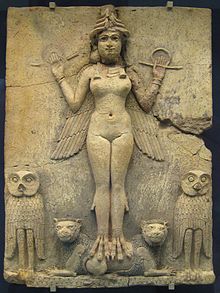
Assyria was a major ancient Mesopotamian civilization which existed as a city-state from the 21st century BC to the 14th century BC, then to a territorial state, and eventually an empire from the 14th century BC to the 7th century BC.

Enlil, later known as Elil and Ellil, is an ancient Mesopotamian god associated with wind, air, earth, and storms. He is first attested as the chief deity of the Sumerian pantheon, but he was later worshipped by the Akkadians, Babylonians, Assyrians, and Hurrians. Enlil's primary center of worship was the Ekur temple in the city of Nippur, which was believed to have been built by Enlil himself and was regarded as the "mooring-rope" of heaven and earth. He is also sometimes referred to in Sumerian texts as Nunamnir. According to one Sumerian hymn, Enlil himself was so holy that not even the other gods could look upon him. Enlil rose to prominence during the twenty-fourth century BC with the rise of Nippur. His cult fell into decline after Nippur was sacked by the Elamites in 1230 BC and he was eventually supplanted as the chief god of the Mesopotamian pantheon by the Babylonian national god Marduk.
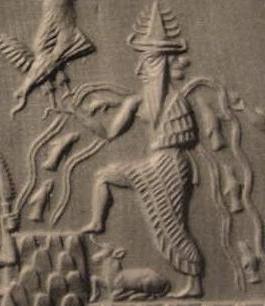
Enki is the Sumerian god of water, knowledge (gestú), crafts (gašam), and creation (nudimmud), and one of the Anunnaki. He was later known as Ea or Ae in Akkadian (Assyrian-Babylonian) religion, and is identified by some scholars with Ia in Canaanite religion. The name was rendered Aos in Greek sources.

Babylonia was an ancient Akkadian-speaking state and cultural area based in the city of Babylon in central-southern Mesopotamia. It emerged as an Akkadian populated but Amorite-ruled state c. 1894 BC. During the reign of Hammurabi and afterwards, Babylonia was retrospectively called "the country of Akkad", a deliberate archaism in reference to the previous glory of the Akkadian Empire. It was often involved in rivalry with the older ethno-linguistically related state of Assyria in the north of Mesopotamia and Elam to the east in Ancient Iran. Babylonia briefly became the major power in the region after Hammurabi created a short-lived empire, succeeding the earlier Akkadian Empire, Third Dynasty of Ur, and Old Assyrian Empire. The Babylonian Empire rapidly fell apart after the death of Hammurabi and reverted to a small kingdom centered around the city of Babylon.

Sin or Suen (Akkadian: 𒀭𒂗𒍪, dEN.ZU) also known as Nanna (Sumerian: 𒀭𒋀𒆠DŠEŠ.KI, DNANNA) was the Mesopotamian god representing the moon. While these two names originate in two different languages, respectively Akkadian and Sumerian, they were already used interchangeably to refer to one deity in the Early Dynastic period. They were sometimes combined into the double name Nanna-Suen. A third well attested name is Dilimbabbar (𒀭𒀸𒁽𒌓). Additionally, the moon god could be represented by logograms reflecting his lunar character, such as d30 (𒀭𒌍), referring to days in the lunar month or dU4.SAKAR (𒀭𒌓𒊬), derived from a term referring to the crescent. In addition to his astral role, Sin was also closely associated with cattle herding. Furthermore, there is some evidence that he could serve as a judge of the dead in the underworld. A distinct tradition in which he was regarded either as a god of equal status as the usual heads of the Mesopotamian pantheon, Enlil and Anu, or as a king of the gods in his own right, is also attested, though it only had limited recognition. In Mesopotamian art, his symbol was the crescent. When depicted anthropomorphically, he typically either wore headwear decorated with it or held a staff topped with it, though on kudurru the crescent alone served as a representation of him. He was also associated with boats.

Marduk is a god from ancient Mesopotamia and patron deity of the city of Babylon who eventually rose to power in the First Millennium BC. In the city of Babylon, Marduk was worshipped in the temple Esagila. His symbol is the spade and he is associated with the Mušḫuššu.

Bêl is a title signifying 'lord' or 'master' applied to various gods in the Mesopotamian religion of Akkad, Assyria, and Babylonia. The feminine form is Bêlit in Akkadian. Bel is represented in Greek as Belos and in Latin as Belus. Belit appears in Greek form as Beltis (Βελτις). Linguistically, Bel is an East Semitic form cognate with the Northwest Semitic Baal with the same meaning.

Ninurta (Sumerian: 𒀭𒊩𒌆𒅁: DNIN.URTA, possible meaning "Lord [of] Barley"), also known as Ninĝirsu (Sumerian: 𒀭𒎏𒄈𒋢: DNIN.ĜIR2.SU, meaning "Lord [of] Girsu"), is an ancient Mesopotamian god associated with farming, healing, hunting, law, scribes, and war who was first worshipped in early Sumer. In the earliest records, he is a god of agriculture and healing, who cures humans of sicknesses and releases them from the power of demons. In later times, as Mesopotamia grew more militarized, he became a warrior deity, though he retained many of his earlier agricultural attributes. He was regarded as the son of the chief god Enlil and his main cult center in Sumer was the Eshumesha temple in Nippur. Ninĝirsu was honored by King Gudea of Lagash (ruled 2144–2124 BC), who rebuilt Ninĝirsu's temple in Lagash. Later, Ninurta became beloved by the Assyrians as a formidable warrior. The Assyrian king Ashurnasirpal II (ruled 883–859 BC) built a massive temple for him at Kalhu, which became his most important cult center from then on.
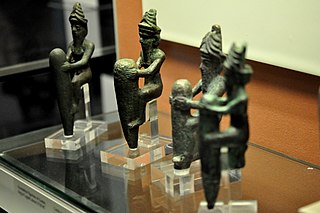
The Anunnaki are a group of deities of the ancient Sumerians, Akkadians, Assyrians and Babylonians. In the earliest Sumerian writings about them, which come from the Post-Akkadian period, the Anunnaki are deities in the pantheon, descendants of An and Ki, the god of the heavens and the goddess of earth, and their primary function was to decree the fates of humanity. They should not be confused with the Apkallu.
Ancient Semitic religion encompasses the polytheistic religions of the Semitic peoples from the ancient Near East and Northeast Africa. Since the term Semitic itself represents a rough category when referring to cultures, as opposed to languages, the definitive bounds of the term "ancient Semitic religion" are only approximate, but exclude the religions of "non-Semitic" speakers of the region such as Egyptians, Elamites, Hittites, Hurrians, Mitanni, Urartians, Luwians, Minoans, Greeks, Phrygians, Lydians, Persians, Medes, Philistines and Parthians.

Babylonian religion is the religious practice of Babylonia. Babylonia's mythology was greatly influenced by its Sumerian counterparts and was written on clay tablets inscribed with the cuneiform script derived from Sumerian cuneiform. The myths were usually either written in Sumerian or Akkadian. Some Babylonian texts were translations into Akkadian from Sumerian of earlier texts, but the names of some deities were changed.

The Neo-Babylonian Empire or Second Babylonian Empire, historically known as the Chaldean Empire, was the last polity ruled by monarchs native to Mesopotamia. Beginning with the coronation of Nabopolassar as the King of Babylon in 626 BC and being firmly established through the fall of the Assyrian Empire in 612 BC, the Neo-Babylonian Empire was conquered by the Achaemenid Persian Empire in 539 BC, marking the collapse of the Chaldean dynasty less than a century after its founding.
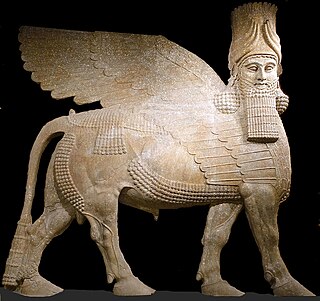
The history of the Assyrians encompasses nearly five millennia, covering the history of the ancient Mesopotamian civilization of Assyria, including its territory, culture and people, as well as the later history of the Assyrian people after the fall of the Neo-Assyrian Empire in 609 BC. For purposes of historiography, ancient Assyrian history is often divided by modern researchers, based on political events and gradual changes in language, into the Early Assyrian, Old Assyrian, Middle Assyrian, Neo-Assyrian and post-imperial periods., Sassanid era Asoristan from 240 AD until 637 AD and the post Islamic Conquest period until the present day.

Ashur, Ashshur, also spelled Ašur, Aššur was the national god of the Assyrians in ancient times until their gradual conversion to Christianity between the 1st and 5th centuries AD.

Marduk-nādin-aḫḫē, inscribed mdAMAR.UTU-na-din-MU, reigned c. 1095–1078 BC, was the sixth king of the Second Dynasty of Isin and the 4th Dynasty of Babylon. He is best known for his restoration of the Eganunmaḫ in Ur and the famines and droughts that accompanied his reign.

The Middle Assyrian Empire was the third stage of Assyrian history, covering the history of Assyria from the accession of Ashur-uballit I c. 1365 BC and the rise of Assyria as a territorial kingdom to the death of Ashur-dan II in 912 BC. The Middle Assyrian Empire was Assyria's first true period of ascendancy as an empire, although Assyrian kings had existed from perhaps as early as the 25th century BC, and from the 21st century BC Assyria had controlled trading colonies in Anatolia and had economic and military influence in Southern Mesopotamia, and from the late 19th century BC had been an integral part of the "Empire of Shamsi-Adad", sometimes called the Old Assyrian Empire. Though the empire experienced successive periods of expansion and decline, it remained the dominant power of Mesopotamia and often the entirety of West Asia throughout the period. In terms of Assyrian history, the Middle Assyrian period was marked by important social, political and religious developments, including the rising prominence of both the Assyrian king and the Assyrian national deity Ashur.

Anu or Anum, originally An, was the divine personification of the sky, king of the gods, and ancestor of many of the deities in ancient Mesopotamian religion. He was regarded as a source of both divine and human kingship, and opens the enumerations of deities in many Mesopotamian texts. At the same time, his role was largely passive, and he was not commonly worshipped. It is sometimes proposed that the Eanna temple located in Uruk originally belonged to him, rather than Inanna, but while he is well attested as one of its divine inhabitants, there is no evidence that the main deity of the temple ever changed, and Inanna was already associated with it in the earliest sources. After it declined, a new theological system developed in the same city under Seleucid rule, resulting in Anu being redefined as an active deity. As a result he was actively worshipped by inhabitants of the city in the final centuries of the history of ancient Mesopotamia.
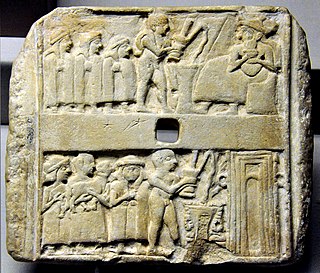
Sumerian religion was the religion practiced by the people of Sumer, the first literate civilization found in recorded history and based in ancient Mesopotamia. The Sumerians regarded their divinities as responsible for all matters pertaining to the natural and social orders.

Akkadian or Mesopotamian royal titulary refers to the royal titles and epithets assumed by monarchs in Ancient Mesopotamia from the Akkadian period to the fall of the Neo-Babylonian Empire, with some scant usage in the later Achaemenid and Seleucid periods. The titles and the order they were presented in varied from king to king, with similarities between kings usually being because of a king's explicit choice to align himself with a predecessor. Some titles, like the Akkadian šar kibrāt erbetti and šar kiššatim and the Neo-Sumerian šar māt Šumeri u Akkadi would remain in use for more than a thousand years through several different empires and others were only used by a single king.
The post-imperial period was the final stage of ancient Assyrian history, covering the history of the Assyrian heartland from the fall of the Neo-Assyrian Empire in 609 BC to the final sack and destruction of Assur, Assyria's ancient religious capital, by the Sasanian Empire c. AD 240–250, though Assyria was to endure as the geopolitical entity of Asoristan until the mid 7th century AD. There was no single independent Assyrian state during this time, with Assur and other Assyrian cities instead falling under the control of the successive Median, Neo-Babylonian, Achaemenid, Seleucid and Parthian empires. The period was marked by the continuance of ancient Assyrian culture, traditions and religion, despite the lack of an Assyrian kingdom. The ancient Assyrian dialect of the Akkadian language went extinct however, completely replaced by Aramaic by the 5th century BC, a process that had begun during the Neo-Assyrian Empire.



